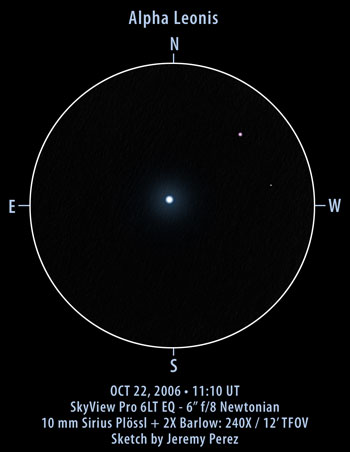
Observation Notes:
Regulus makes for a wide double with a brilliant blue-white primary that gave a reddish purple appearance to its G-type secondary star. Separation appeared to be 1/3 of the field of view, or about 240 arc seconds. The actual value is 178 arc seconds (or about 1/4 of the field). So I managed to mess that estimate up a bit. My PA estimate of 315 degrees was in pretty good shape compared to the actual value of 307 degrees.
| Subject | Alpha Leonis (Regulus / STF 6) |
| Classification | Double Star |
| Position (J2000) | [RA: 10:08:22.1 / Dec: +11:58:01]* |
| Position Angle* | 307° (1836) |
| Separation* | 177.6" (1960) |
| Magnitudes* | A = 1.35; B = 8.12 |
| Spectral Types* | A = B7V; B = G |
| Date/Time | OCT 22, 2006 - 04:10 AM MST (OCT 22, 2006 - 11:10 UT) |
| Observing Loc. | Cinder Hills Overlook, Sunset Crater National Monument, AZ |
| Instrument | Orion SVP 6LT Reflector (150 mm dia./1200 mm F/L) |
| Eyepieces/Mag. | 10 mm + 2X Barlow (240X) |
| Conditions | Clear, calm |
| Seeing | 5/10 |
| Transparency | NELM Mag 6.8+ |
| References | The Washington Visual Double Star Catalog, 1996.0 (Worley+, 1996), Visual Double Stars in Hipparcos (Dommanget+, 2000) via VizieR |
*Based on published data.




